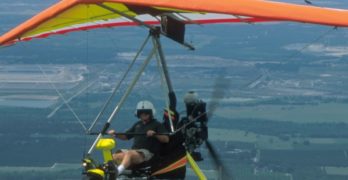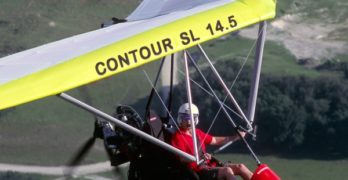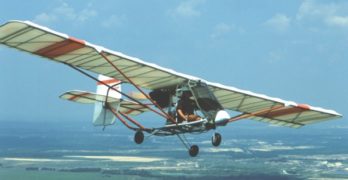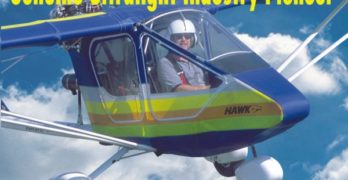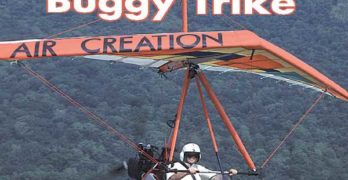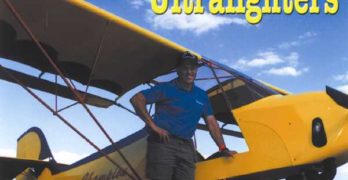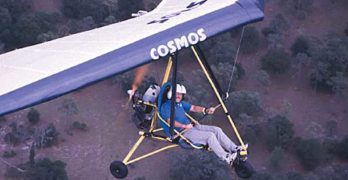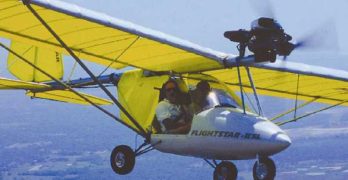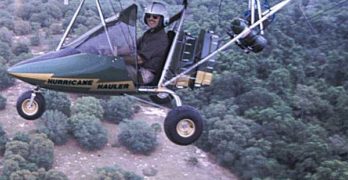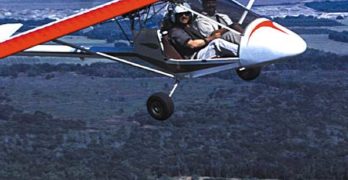Not long ago, Americans couldn’t buy products from South Africa because of that country’s apartheid policies. Our government employed economic sanctions that kept South African aviation developments off our radar. However, as their ultralight producers did business with Europe, the Southern Hemisphere country kept up with ultralight aviation despite the sanctions imposed by the United States.
One South African ultralight product is the Aquilla, a sturdy trike from Solo Wings in South Africa.
If the name Aquilla sounds vaguely familiar and a bit Italian to you, go to the head of the class. You’d be right on both counts. Aquila – spelled with one “l” – is a constellation in the Northern Hemisphere and the Milky Way. Exactly how a star in the northern skies inspired someone in South Africa I don’t know. Aquila is also a city of central Italy northeast of Rome.
Nonetheless, Solo Wings owner Aidan De Gersigny, who has been involved with hang gliding since the late 1970s, says Aquilla means “Eagle” in Latin, a name he used for a hang glider he sold 15 years ago.
Search Results for : CT AND hand control
Not finding exactly what you expected? Try our advanced search option.
Select a manufacturer to go straight to all our content about that manufacturer.
Select an aircraft model to go straight to all our content about that model.
North Wing Prepares the Apache Sport
Trike and trike wing manufacturer North Wing Design has debuted a new trike called the Apache Sport. Developed for the proposed Light-Sport Aircraft category, this new 2-seater can also be operated as an ultralight trainer qualifying under the training exemption to FAR Part 103.
Barely a year after the new millennia dawned, North Wing Design introduced their first new 2-seat trike to the ultralight community – the original Apache. In the last year of the old century, the Washington-based company offered their first trike – the single-seat Maverick with its distinctive strutted wing.
Prior to these developments, North Wing Design was a trike wing supplier. For many years, small manufacturers of trike carriages have been buying wings from North Wing because they handle and perform handsomely. In a still-earlier role, the company was a savior to owners of certain brands of hang gliders whose manufacturers had left the business.
North Wing came to the aid of these stranded owners.
Slipstream Industries’ Simple Scepter
To many observers, SlipStream Industries is a different ultralight company. As they exhibit in the ultralight areas of big airshows, we know their heart is in the right place (as far as Ultralight Flying! readers are concerned anyway). But they also make twin-engine aircraft.
One way SlipStream distinguishes itself among all light aviation enterprises is by offering not one, but two twin-engine aircraft. The line-up includes the SkyBlaster, which was recently renamed Gemini Twin to differentiate the name from SkyQuest, SlipStream’s other twin. Gemini Twin is a rare fore-and-aft arrangement using two 50-hp Rotax 503 engines. Certainly it is the only one with this configuration in the ultralight field and it draws some analogy to the famous Cessna Sky Master. Hence its closely related former name.
Before the SkyBlaster/Gemini Twin, SlipStream developed and still sells another twin, the SkyQuest. Like its sibling, this twin aft engine pusher design uses the ultralight-standard 50-hp Rotax 503 dual carb as powerplants.
Hawk (at 20 years)
The nation is focused on the celebration of 100 years of powered flight, thanks to efforts by a couple of Ohio brothers in 1903. But ultralight aviation has its own bigger-than-life hero from yesteryear and he’s also from Ohio.
Chuck Slusarczyk needs no introduction because almost everyone involved with ultralight aviation for any length of time knows the jolly designer of the Hawk series of ultralights.
Chuck first flew gliders just as did Orville and Wilbur Wright. Like the famous Wrights, he ignored those who said he couldn’t do what he hoped to do – in Chuck’s case, bring to market an ultralight that broke new ground in several important ways. For one, you had no chance to foot-launch it.For those who became ultralight enthusiasts more recently, the rule in the early 1980s – before passage of FAR Part 103 – was that ultralights had to be foot-launchable. When Slusarczyk first introduced the Hawk, a demonstration of foot-launching was required; since the Hawk was fully enclosed, the pilot could not provide the demonstration, if asked.
Buggy + XP
Red is the best color for marketing reasons I was told by a Detroit car marketing executive with a half million a year salary. If you’ve seen a Chrysler TV ad recently, you can see they painted all the cars and trucks bright red.
Published in Light Sport and Ultralight Flying
Seating
Single- or 2-seat
Empty weight
386 pounds
Gross weight
772 pounds
Wingspan
30 feet
Wing area
135 square feet
Wing loading
5.7 pounds/sq ft
Wing
Trike
Height
11 feet 7 inches
Fuel Capacity
9.9 gallons
Kit type
Assembly
Build time
30-60 hours
Standard engine
Rotax 582
Power
65 horsepower
Power loading
11.9 pounds/hp
Cruise speed
56-74 mph
Never exceed speed
87 mph
Rate of climb at gross
1,477 fpm
Standard Features
Twin trike carriage, XP 12 double-surface wing, weight-shift control, hand and foot throttles, steerable nosewheel (push-left, go-right) with brake and mudguard, parking brake, wheel pants, pneumatic suspension, instrument panel, lap seat belt, regulator, water temp, Rotax C gearbox, intake/exhaust silencers, full fairing with windshield, 3-blade composite prop, back seat storage.
Champion Ultralight
Avid Aircraft has never indicated a lot of interest, sticking to their popular 2-place models and moving more in the direction of features like a Lycoming (general aviation) engine rather than downsizing.
Published in Light Sport and Ultralight Flying
Seating
Single-seat
Empty weight
284 pounds
Gross weight
560 pounds
Wingspan
26 feet 9.5 inches
Wing area
114.5 sq ft
Wing loading
4.9 lbs/sq ft
Length
17 feet 7 inches (18 ft 9 in wings folded)
Height
6 feet
Fuel Capacity
5 gallons
Kit type
Construction
Build time
200 hours
Standard engine
Rotax 447
Power
40 horsepower
Power loading
14.0 pounds/hp
Cruise speed
63 mph
Never exceed speed
80 mph
Rate of climb at gross
700 fpm
Takeoff distance at gross
75 feet
Landing distance at gross
100 feet
Standard Features
Folding wings (3 minutes), towable on its own wheels, steerable tailwheel, four-point safety harness, Lexan® windshield, instrument panel, adjustable seat, 5-inch main wheels with tubeless tires, 5-gallon wing tank with quick drain, Piper Cub-type main gear shock absorber, engine mount and universal engine adapter plate.
Cosmos Samba
You may know pilots like this. Heck, you might be one of these folks. Large numbers of them help manufacturers get trick new hardware on the market. Their willingness to try fresh concepts and their enthusiasm for all things new make purists an essential part of flying.
One type of flying purist is the sort who prefers to stick with a FAR Part 103 ultralight. The genre helps define ultralights in general – we fly them because we like them, not because we’re hoping to grow up and become an airline pilot someday. Purists prefer the simple honesty of Part 103 flight.
Slow-flying ultralights allow flight closer to fields and trees and landmarks. Amazingly short takeoff rolls and uneventful stalls make these basic machines easy to enjoy and give them versatility as to the size airstrip required. Low cost and operating expense help convince even more pilots. So, if all these things are good, why not make them the best they can be – the slowest flight, the shortest takeoff, the lowest cost?
Flightstar II SL
Since Tom Peghiny and partner Spark Lamontagne first lightened the Flightstar and named one model the II SL (for “Sport Light”), they haven’t been able to sit still and simply admire their work. From our first pilot’s report on the SL 3 years ago,1 the two have tweaked and adjusted the model to find even better qualities.
A new front and aft fairing are part of the package, and the latter you might notice rather quickly. Virtually all the rest of the improvements are subtle things. In fact, that word is a hallmark of Flightstar innovation.
No surprise then that the company should adopt “New and Improved” as its new advertising headline to assure you know about the changes.
Better and Better
I’ve followed the Flightstar from its first flight, when it wasn’t even the Flightstar. This design – which once crossed the Atlantic – is from the inventive mind of Swiss national Hans Gygax, and became the rather gaudy 440ST.
HKS Hurricane Hauler
Last year, the 60-hp HKS 700E 4-cycle engine burst on the ultralight scene with more impact than I’ve noted since Rotax established itself as the engine of choice for ultralight enthusiasts. Among those embracing the new designed-for-light-aircraft powerplant was HY-TEK Hurricane, manufacturer of the Hurricane brand.
In the years since Mike Kern took over the Hurricane, he has shown savvy about the ultralight marketplace. He was able to see where he could enlarge his potential customer base, and his quick acceptance of the newly-available engine proves this.
Despite years of good success with high power-to-weight ratio 2-stroke engines, lots of would-be ultralight buyers remain unconvinced. A Hurricane with a 4-stroke gives HY-TEK the chance to appeal to those buyers and more.
In addition to ultralight enthusiasts looking for more, Kern sees a market in those hordes of Cessna drivers who want something different. A new Hurricane with the HKS 700E fitted is priced below all but the most worn-out general aviation planes, and can be more fun than operating a heavier aircraft that was built as a transportation device rather than a joy machine.
New Kolb Aircraft
Sometimes I’m amazed that we’ve now got ultralight pilots buying engines that cost more than $10,000. Twenty years ago, Eipper Formance (Quicksilver) sold complete ultralights that cost $3,499. Even in the ’90s, many complete ultralights – engine and all – cost less than the price of a Rotax 912 4-stroke engine on its own. One that meets that description is Kolb Aircraft’s Mark III with a 50-hp Rotax 503 dual carb 2-cycle engine.
Nonetheless, the 81-hp Rotax 912 has invaded the realm of what is loosely called “ultralight” flying. Of course, a Rotax 912-powered aircraft simply cannot be used on a single-place Part 103 ultralight. And any 2-place plane with a 912 is less likely to qualify as an ultralight trainer under the training exemption to FAR Part 103; the big engine may push the plane too fast and could make it heavier than 496 pounds (the ultralight trainer empty weight limit).
- « Previous Page
- 1
- …
- 54
- 55
- 56
- 57
- 58
- …
- 62
- Next Page »


